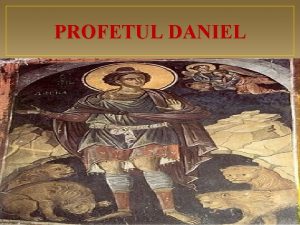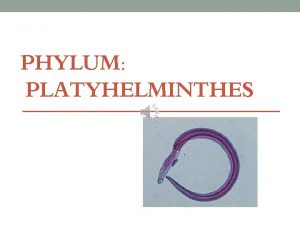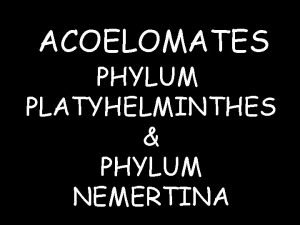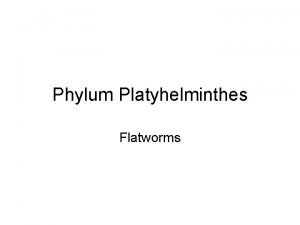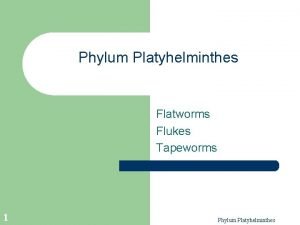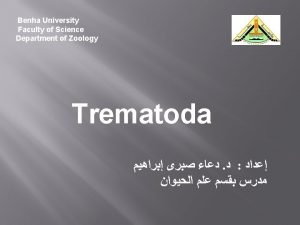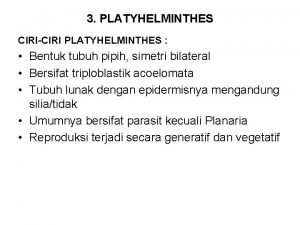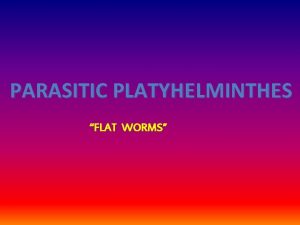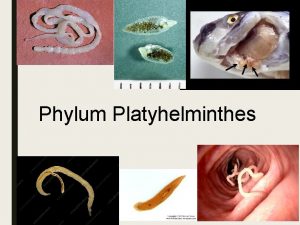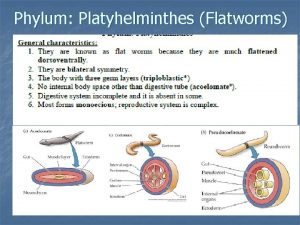Platyhelminthes Emily Azaria Chris Period 5 General Description
















- Slides: 16

Platyhelminthes Emily, Azaria, Chris Period 5

General Description ● ● Phylum- Platyhelminthes contains flatworms Soft, unsegmented, & flat (no more than a few mm thick) Tissues (tripoblastic) & internal organ systems Simplest animals to have: 3 embryonic germ layers, bilateral symmetry, & cephalization ● Do not have coeloms (body cavity) ● Live in fresh or marine water ● Most of their oxygen through diffusion

Symmetry ● ● No body cavity- aceolomates Bilateral symmetry Gastrovascular cavity with one opening Some breath through skin

Feeding ● Parasites- enter body of other organisms, can absorb and consume what the host eats ● 80% are free living ● Turbellaria- carnivores (tiny aquatic invertebrates)

Circulation ● Flatworms take in oxygen and release carbon dioxide ● Flatworms don’t undergo cellular respiration ● Flatworms undergo diffusion to obtain the oxygen they need, and release carbon dioxide they don’t ● This is mostly the reason why they’re flat Central nervous system: the complex of nerve tissues that controls the activities of the body.

Excretion ● The digestive cavity has only one opening for both intake of food and the excretion of it ● As a result the food cannot be processed continuously ● Cilia help move foods to be digested and then excreted through their mouths Pharynx: the membrane-lined cavity behind the nose and mouth, connecting them to the esophagus. Flame cell: a specialized excretory cell- function like a kidney, removing waste materials.

Response ● They have ganglia ● Have a complex structure for detecting and responding to external stimuli ● Have eyespots that can detect changes in the amount of light in their environment ● Have specialized cells that detect external stimuli

Movement ● Free-living ● Uses cilia and muscle cells

Reproduction ● ● ● Most are hermaphrodites Reproduce sexually with internal fertilization Parasitic Commonly reproduce asexually by fission Can reproduce sexually

Respiration ● Gas exchange ● Uses diffusion

Classes of Platyhelminthes 1. Trematoda 2. Turbellaria 3. Cestoda

Trematoda ● Parasites ● Infect animals and humans ● Specialized body (Parasitic life) ● Fasciola hepatica (Liver

Turbellaria ● Free living flatworms ● Most are aquatic ● Some are terrestrial ● Planaria

Cestoda ● Tape worms ● Intestinal parasites ● Proglottid: segment containing complete reproductive system ● Taenia solium (Pork tapeworm)

Works Cited https: //www. shapeoflife. org/video/flatworms-first-hunter https: //excreting 101. weebly. com/platyhelminthes. html

The End
 Profetul daniel
Profetul daniel What are platyhelminthes characteristics
What are platyhelminthes characteristics Critical period vs sensitive period
Critical period vs sensitive period A&p flix activity: propagation of an action potential
A&p flix activity: propagation of an action potential When is the relative refractory period
When is the relative refractory period Critical period vs sensitive period
Critical period vs sensitive period Critical vs sensitive period examples
Critical vs sensitive period examples Approaches to child development
Approaches to child development The classical period started from 1750 to 1872
The classical period started from 1750 to 1872 Non metal halogen family atomic mass 35
Non metal halogen family atomic mass 35 What served as the seed of activism?
What served as the seed of activism? Stability period vs measurement period
Stability period vs measurement period Trustee period and royal period
Trustee period and royal period Bc va ad
Bc va ad General appearance definition
General appearance definition Planos en cinematografia
Planos en cinematografia Where did general lee surrender to general grant?
Where did general lee surrender to general grant?
